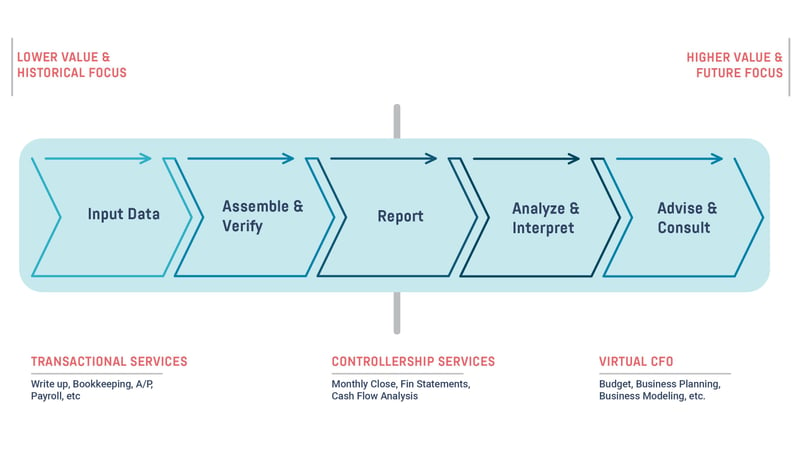As accounting firms see what is arguably the biggest sea change in the history of the profession, they’re looking to keep up with the value today’s clients expect. Traditional services have largely become commoditized and automated. Less and less of firms’ revenue is coming from traditional areas like tax and audit. For those firms changing with the times, moving to Client Advisory Services, or CAS, plays an enormous part in becoming what visionaries in the profession have termed the “firm of the future.”
WHAT IS CAS? (Client Advisory Services)
In just the past decade or so, the amount of data companies have been able to tease from their operations and beyond has increased 48 times, to an eye-watering 97 zettabytes (that’s 97 TRILLION terabytes, and no, your hard drive is NOT that big).
That statistic alone speaks to the rising difficulties organizations have in sorting, analyzing and developing insights from the data available to them. And now that 90% of all data is unstructured, all new sets of skills in analysis are required of the professionals who mine data for the nuggets of information that will give them a competitive or performative edge.
This rise of data has created nearly as many complications as it has advantages; while businesses can gain heretofore unimagined insights from the data available to them, that data must be cleaned, verified, checked and sometimes compared with additional data sets before any confidence can be found in its analysis. Drawing conclusions and making decisions based on data analysis requires even more skill, which oftentimes means combining both Business Intelligence and Data Science.
If all of this seems dizzyingly complex, that’s because it is. The very presence and synthesis of all this information has given rise to all new business processes, planning and expectations. And while it’s very much a fact-based science, there’s just enough art to it to confound many professionals and drive deep, seemingly impossible-to-answer questions.
The very biggest companies employ data scientists and analysts to help make sense of this ocean of information, but such hires are often beyond smaller organizations. So these functions could be assigned to under-qualified and already-overloaded existing employees, or they could be sourced to a third party.
The analysis and interpretation of all this data is the foundation of a Client Advisory Services (CAS) practice, and building a successful one is far from simple. For many accountants, the problem doesn’t necessarily lie in data analytics or even interpretation, but in presenting insights to the client. Unlike the far more objective traditional accounting work, communicating data insights requires a combination of finesse and soft skills such as communication in order to provide real service. These skills aren't always easy to master, but they're more than worth the time you put into learning them. Get comfortable with advisory by getting comfortable first with soft skills.
For accounting profession visionaries and leaders, CAS practices are what make “the firm of the future.” This firm will cover a range of CAS functions (sometimes referred to as CAS 1.0, 1,5 and 2.0, indicating levels of firm services) and will not only be comfortable with large data sets, but also adept and efficient with them. Practitioners will facilitate clients’ comprehension of the insights and recommendations they glean from the data they have access to.
By Any Other Name...
Further complicating the picture is what some term as “Client Accounting Services,” which of course ALSO creates a “CAS” acronym. If that’s not enough to blow your mind, be aware that accounting services, when offered in the cloud via a kind of “virtual” accounting department, ALSO constitute a kind of client advisory service better-known as CAS 1.0. Other names for these services can include: Financial Accounting Services (FAO), Business Process Outsourcing (BPO), Virtual Outsourced Accounting (VOA), Client Accounting and Advisory Services (CAAS), Biz Ops, and a handful of branded, trademarked names for advisory services.
For clients, CAS services represent a revolution in business insight and planning, taking them a step closer to objective decision-making and continuous insight, and providing them with an opportunity to optimize their resources as never before. They might not know what to call it, but these are services clients are increasingly demanding; and they’re looking to their trusted advisors to provide them.
What CAS isn't, is bookkeeping, write-up, or after-the-fact reporting.
For firms, CAS quite simply represents the future itself: it’s the fastest-growing new revenue source, providing high profitability and predictable, ongoing revenue.
Making the shift to CLIENT advisory
It’d be a wonderful thing if you could wake up tomorrow, wave the proverbial magic wand and proclaim your firm to be a CAS practice. And if you find that wand, please let the rest of us know. Until then, building a CAS practice will continue to mean more than simply adding new services.
Consider where you might be now on the spectrum of transactional to advisory services and ask yourself: where are you now and where do you want to be in 2 years, 5 years, etc. Even more importantly, what are you doing to get there?

A CAS practice has deep dedication to client service. CAS services drive client interaction, require thoughtful inputs and informed analysis, and synthesize actionable intelligence. They then demand suggestions as to what those actions should be, supported by the analysis and the data that informed it.
It’s not for the faint-of-heart for sure, but its value to clients is off the charts. And guess what? It’s what they’re expecting NOW.
If you find yourself with lots of questions, that's pretty normal. While there isn't any one way to accomplish building and running a CAS department in your firm, many of your questions have been asked by others and answered by experts in the field.

Training, education and upskilling
Having a CAS partner is crucial to a firm's success. This leader needs to be laser-focused on building this new part of the firm's business and the team that will execute against their strategies. That partner should also create a CAS business plan that has actionable items and reasonable timelines. CAS lead needs to have 100% focus on building out the predictable, profitable, monthly recurring revenue.
Extensive education in two parts (a workshop followed by a certification course) is available via AICPA and CPA.com, and it gives CPE to boot. There are other solutions available as well, but here are some of the things you should look for when choosing training:
-
Understanding CAS and its benefits
-
Staffing for CAS
-
Creating a firm model for workflow
-
Communicating with clients
In addition to this, employees working within CAS should get additional training on soft skills, including:
-
General communication
-
Problem solving
-
Time management
-
Critical thinking skills
-
Collaboration
-
Organization
-
“Big-picture” thinking
-
Persuasion
CAS services require a full and varied set of skills; skimping on any of them could be a detriment to your practice. However, the rewards are more than worth the comparatively small investment of time in training.
Hiring dedicated resources
Hiring talent from a firm that's already built CAS will have you off to races faster, but finding this talent is difficult and tends to be expensive as well. Candidates should first be technology-minded, with experience in cloud technology like QBO, Bill.com, etc.
When hiring for CAS-oriented positions, be sure to keep your client base in mind. Ask questions that will help you see how the prospect might fit into your client picture; do they seem to understand the importance of ongoing client communication? Do they have experience in your vertical, if applicable? Can they articulate a plan for offering and managing advisory services to a client base like yours?
Hiring qualified candidates will speed your time to market with CAS services, but remember: if you don’t already offer them, you still have to structure and develop a workflow for your services, price them appropriately and market them. Just hiring a handful of excellent candidates only gets you part way there. The good news is, the right, experienced hires can help you design the rest in record time.

Where does CAS fit in your existing structure?
CAS is not just another offering. Client advisory services represents a shift in thinking for firms, from a compliance practice to an advisory practice. Market demand for CAS is high, so it’s likely you’ll grow quickly. A client discovery process can help ease transitions and work—and many firms charge for this service. You may find yourself participating in your clients’ decision-making on a daily basis. So there are some rules to making sure you’re giving CAS its due:
-
Staff CAS with top talent just like you do tax or audit
Your traditional client services (your cash cows) succeed because you have the best staff, the best processes and the best client base. CAS is no different.
-
Don’t expect an overnight sensation
Your first CAS clients are likely to be clients you already have who are in need of, and possibly have specifically asked you for advisory service. But you’ll need time to work out some of the bugs, on top of needing to create a pipeline of new clients you’ve identified as good potential users of advisory services.
- Be sure to let clients and prospects know what you're offering.
Ignore marketing at your own peril. How can clients find you if they don't know what you do? Be sure to create a dedicated area on your website for advisory services, discuss those services with existing clients who could use them, and make use of social media and email to get the word out. If you have rival firms you often compete with, pay attention to what they're doing in the media and marketplace—and be prepared to be there with your own offering too.
-
Understand that this is a game of good input=good output
It could be tempting to not give CAS the focus it needs once you have things set up and rolling. Unlike transactional services, CAS doesn’t survive on quarterly, monthly or seasonal deadlines. It’s ongoing, and always in need of nurture if you want to reap the benefits. Drop the ball one too many times, and you might not just lose a client, you might lose a reputation.
-
Make sure firm leadership is onboard
However serious you might be about CAS, without the support of firm leadership you will struggle for success. Be able to confidently relay the value of client advisory services internally. Help firm leadership see the benefits and walk them through its tenets. Get them as excited about it as you are.
Capacity issues are the #1 blocker
There are more businesses than bookkeepers. On top of this, there’s more data to be sorted, scrubbed and analyzed than ever before. This leaves firms in a tough spot, where they lack the time and talent to advise clients. If that’s the case for you, then you’ll want to explore ways to increase your capacity.
-
Automate, automate, automate.
Anything your firm is doing manually that has an automated solution is worth exploring. In particular, tasks like bookkeeping swallow tons of time and resources for relatively little return, and can be easily automated. The time you recover can be repurposed into CAS services, which offer a far more attractive margin.
-
Look at culling your client roster
Have you cleaned house lately? When you start offering CAS services, it’s a good time to review your client base to determine which are not willing to follow standardized processes or are not delivering the revenue you hoped they would.
-
Consider some options for increasing efficiency
This might sound like a “duh!” suggestion, but think about whether you’ve ever ACTUALLY documented processes and audited compliance. Is equipment up-to-date? Is the office environment conducive to getting things done? Does staff have sufficient downtime? Do you provide ways for them to disconnect during the day for their breaks? All of these things and more can help you increase efficiency.
The three "A"s: Accounting, Automation, and Advisory

Accounting
Today’s firms are experiencing changes in revenue growth. In traditional firms, bookkeeping makes up around 10% of their revenue. Many firms still offer clean up work at low cost to get tax clients. Many won’t even touch bill pay or payroll.
Bookkeeping is time-intensive and expensive to provide manually, and many clients no longer want to have their bookkeeping done in-house. Instead, there’s a massive trend to outsource to a firm. Why?
-
The client might have outgrown a bookkeeper and need more
-
Their books are a mess, they don’t know their numbers or how to clean things up
-
Clients need dashboards to see real-time data
-
The firm’s value is in a skillset that differs from the client’s own staff
-
With a firm, the client gets a whole team, technology, and better processes
-
Payroll, bill pay, sales & use tax, HR are all painful and confusing (getting more and more complex)
-
They’re seeking more forward-looking business advice and counsel
-
They have difficulty keeping a bookkeeper on staff
-
With a firm:
-
The knowledge doesn’t walk out of the door
-
Someone is always “there”
-
Less worry over the expense of turnover
-
No need to deal with payout of PTO, fringe benefits
On the other hand, firms struggle with offering these virtual outsourced services because the firm structure doesn’t support building out this part of the practice. Firms are struggling with some of these realities:
-
Partner accountability is more intense than ever
-
Fee pressure is huge
-
Complexity is at new heights due to COVID, PPP
-
Regulation
-
Customers requesting to be paperless & asking for dashboards
-
The war for talent and Great Resignation
-
New venture-backed firms have entered the market
-
Staff wanting to remain working from home
-
Staff workflow tools needed for remote teams
So there’s a disconnect. Clients don’t want to do this work themselves, and firms are finding it harder and harder to meet client demands due to a supply/demand mismatch. Which brings us to the second A.

Automation
Automation is a technology that performs a process or procedure with minimal or no human assistance. It’s a broad term that’s used for everything from lights that turn on by themselves to self-driving cars.
One key aspect of automation is the amount of human intervention involved and the complexity of the task that’s being performed. Put more simply, how much of the full task or procedure is automated? As automation increases, the need for human input or intervention decreases. A fully automated process would require no human to do anything from start to finish.
Another feature of automation is its ability to scale. Consider a computer. If we give it a job to do, it won’t stop doing that job until we tell it to. As long as it has power, it will happily chug away doing whatever we program it to do, never getting sick, taking a vacation, or getting distracted. And for many repetitive, simple tasks, computers are FAR faster and more efficient than people.
A final big consideration in automation is expense. Operating and upkeep costs on a computer and its software nearly always come out far less expensive than having dedicated staff to do the same task. This is handy because as it turns out, computers are still not as good as people at most higher-order tasks, including reasoning, deduction, creativity, and so on.
They also don’t have especially interesting personalities.
In accounting, artificial intelligence can be used to automate workflows such as running payroll or generating financial reports.
Machine learning, a subset of AI, assists by learning from our behavior and recreating actions based on what information is fed into it. Take categorizing transactions, as an example. AI can take information like the name of the transaction and dollar amount and categorize it based on how it’s been categorized previously.
Best of all, the more AI is used and adopted, the more powerful it becomes! If you’re still not clear on how artificial intelligence can help accountants, this article might help.
Advisory
Advisory services are more than just a trend. They’re the future of accounting. There’s been a data revolution in the past few decades, with businesses generating more information about their sales and customer bases than at any time in the past. The businesses that know how to use this data are winning the battle for market dominance. Increasingly, businesses are turning to accountants and advisors to help them sort and make sense of this mountain of data.
The good news for firms is that in many cases, they’re already in possession of the information they need to provide meaningful advisory to their clients. If the firm is already doing bookkeeping and/or tax work for a company, they have the building blocks for advisory in their hands.
But getting to advisory isn’t necessarily simple. Providing advisory takes time, representing capacity your firm might not have. Currently, firm talent is most often used to gather and report on data; they lack the experience to analyze and advise on it. And we’ve already addressed hiring and training for advisory, both of which present added complexity.
As mentioned earlier, building capacity, however, can largely lean on automation. When staff isn’t bogged down with accounting tasks such as bookkeeping, you can refocus them on advisory, which means bigger margins and higher client satisfaction.
Advisory remains part of the overall picture, but it’s quickly becoming the most important part for firms. Those bringing this kind of talent into their firms will find themselves far better positioned for the future.
Developing a cas business plan
Probably the biggest challenge to any new direction in your firm is writing up your plan of attack. There are many different formats to choose from—you can write a traditional business plan, carving out CAS as its own “entity,” (though it will fit into the greater firm of course), you can choose to write a strategic plan without focused financials, or you can even concentrate on operations and touch on budgeting and staffing as supporting factors to be filled in once you have your operational details.
There’s no “correct” way to make your CAS business plan, but you definitely should make one. If you try to start offering CAS services without one, you’re starting at an enormous disadvantage, having not properly scoped your current client base, understood what CAS services you have staff qualified to offer, or even what resources you might need for equipment, tech stack additions or personnel.
Offering CAS services is like starting a new business within your firm, and you need to plan it as carefully as you would starting your firm from the ground up. Here are some primary items you should plan to cover:
Choose a CAS leader
Your firm’s CAS practice needs a strong leader, who has vision and 100% dedication to building a new part of the firm’s practice. This person is ultimately responsible for the success of your CAS practice and open to failing fast in order to succeed, so choose deliberately and carefully.

The duties this position will be responsible for include:
-
Determining which services your firm can and will provide
-
Supervising client service
-
Devising goals and KPIs
-
Monitoring performance
-
Communicating departmental developments, needs and accomplishments to the (other) partners
-
Interviewing and possibly hiring CAS staff as needed
-
Working with your business development leads to provide needed collateral and talking points for CAS services
-
Meeting with serious prospects to assess their needs with your business development leads
-
Working with your IT specialist to address any technical issues or needs specific to the CAS area
While this isn’t a comprehensive list of responsibilities by any measure, it’s a good basis for understanding what you need in a CAS leader. Your mileage will vary somewhat, depending on your available resources and current/desired client base.
Know the clients you’re targeting and your growth goals
When you’re just starting out in your CAS practice, setting up new business on new technology, with new process and value pricing is key. Assessing your current client base and shifting them to CAS is trickier, but many clients are under-served, are hungry for more and will pay more for advisory services.
The 2021 CPA.com CAS Benchmark Survey notes the top five CAS services offered by firms that took the survey:
-
Financial statement preparation (96%)
-
Accounts Payable (90%)
-
Forecasting/budgeting (89%)
-
1099 Creation and Filing (89%)
While these are obviously not all the possible CAS services, they’re likely a good place to start investigating as they’re clearly in demand. You might also need to concentrate your efforts on services you have the expertise and capacity to provide while still driving growth.
Taking an objective look at your client roster, set your organic goals based on the number of clients you feel you can successfully add to the CAS practice, and start talking to your tax partners and clients about the new services your firm would like to provide to help business grow!. Remember that, as with many goals, it’s likely you won’t hit it exactly. But you and your tax partners will be surprised by how easily your firm clients will agree to a monthly rather than annual arrangement once they understand how it benefits them. Especially on a maiden voyage for a strategy, it’s not unusual for professionals to significantly over-or underestimate their potential. And that’s okay. Collect as much data on your efforts as you can while you’re making your pitches.
After your first round efforts, whether you give yourself a quarter or a year, adjust expectations based on the realities you see. Assess your efforts. Here are some questions to ask that will help you adjust your goals:
-
What worked? For clients who bought in, why did they?
-
What didn’t work? For clients you pitched and lost, why did you lose?
-
Do your wins have anything in common? What about your losses?
-
What objections did you hear, and how can you address them in the future?
-
How can you grow your successes? To do so, do you need more efficiency, more staff or better technology?
In the beginning, your goals might look more like a shot in the dark than fully-informed, and again, that’s okay. You need some experience under your belt, and once you have it you can adjust. That’s what your first year or two should be about: collecting data and finding your sweet spots.
Once you’ve done this, you should have the context you need to understand your client profile and set more realistic growth goals.

Education and training
There are many resources for training and coaching:
-
Covergence Coaching has CAP (advisory coaching)
-
Amy Vetter
-
CPA.com offers its CAS Workshop and Assessment Workshop
Pricing for success
Pricing will always be a complex topic with many variables including geography, population, competition, scarcity of talent and much more. One thing that’s certain is the day of the hourly billing is drawing to a close. Limiting, often inaccurate and difficult to track precisely, hourly billing often ends up with a loser.
In value pricing, your scope of work is clearly defined and helps clients understand upfront what to expect from billing, eliminating surprises. This also helps you plan your work, smooth out cash flow, and know with certainty when you’ve been asked to step outside your SOW. In addition to the boon of predictable, recurring monthly revenue, firms can now pay themselves on the first of the month — before the work is done. No more receivables delays.
Many firms struggle jumping right to value pricing, so they start with fixed pricing. Both feature a set price for your services. But fixed pricing starts with defining a service, establishing its cost for you to perform it, and adding your profit margin atop it, representing your value to the client. Value pricing is exactly backwards. It starts with your clients and their perceived value for your services, from which you design your services to cover costs plus your profit. In short, it puts the client first, where they should be.
This is important; if a potential client doesn’t seem to have high regard for the value of your services, they are unlikely to be a good fit for you. On the other hand, clients who understand what your firm is bringing to the table in terms of insights and analysis will be loyal and reliable for years to come.
With value pricing, everyone wins.
Marketing support
However your firm goes about its business development, your efforts will need materials that illustrate what your services are, and how they work. To the extent possible, these materials should be in plain English, with any difficult-to-grasp concepts carefully explained in detail.

Not so long ago, clients expected print materials, and these are still extremely helpful. Having a tangible “leave behind” is an effective way to stay on your prospect’s mind. However, if printing brochures or one-sheets is impractical for you for any reason, you can instead put this content on your most valuable marketing channel — your website. A web-based firm presence is a must in today’s connected marketplace. Populate it with case studies and success stories; business owners appreciate reading how others like them have found success with your services.
Your website makes your essential information easily accessible to the vast majority of your potential and current clients. In addition, it’s easily updated and usable directly by your staff in the sales process. The days of working solely with clients within a 50-mile radius of your office have ended. Today, the cloud allows you to work with clients anywhere in the U.S., virtually.
Your firm’s best marketing mix (your content and the channels it occupies) will vary, but one thing that’s an absolute necessity is ensuring your marketing department or provider understands the new CAS services your firm is providing (making sure they don't use the dreaded B (bookkeeping) word). If your firm has a marketing specialist, they need to spend time with you understanding how CAS is new and unique. Of course, many firms use marketing agencies that specialize in marketing CAS services.
Without PR or advertising, you’ll be missing a valuable source of leads. Without marketing expertise, you’ll lose an opportunity to optimize your language and benefit from the strategic positioning of your services in the market.
You can’t thrive without it.
Leadership support
It goes without saying that nothing in a firm happens unless leadership supports it.
With CAS, however, it isn’t enough just to “approve.” Leadership should be involved and invested in the process of building the practice. They should understand CAS will represent a whole area of the practice, as important as tax or audit, and with just as many needs for resources and attention. Without such commitment, your CAS practice will have trouble getting off the ground.
Make sure leadership reviews your plan and is willing to give it the time and attention it needs to thrive; it won’t succeed overnight. All stakeholders should understand success at the start is often measured in years, not quarters.
There are some simple things you can do to ensure leadership is engaged:
-
Communicate the value of CAS and address any concerns.
-
Clearly state goals and objectives and demonstrate how you’ll deliver updates and reporting on a schedule that makes everyone comfortable.
-
Be honest about the time you believe you’ll need to make CAS work for your firm.
-
Address objections upfront before they’re raised, and provide mitigation for any potential pitfalls or issues that can arise.
-
Furnish leadership with a sufficiently forward-looking (and conservative) revenue forecast.
-
Commit to being a firm of the future, and know that change management is a challenge, but decide together what steps to take to become a firm of the future
-
Give other partners advisory goals and compensate them for helping hit CAS goals
As with growing any book of business, delivering a successful CAS practice means protecting and nurturing it carefully, especially in the early days. With leadership’s buy-in, that task becomes an order of magnitude more simple.






